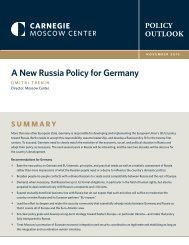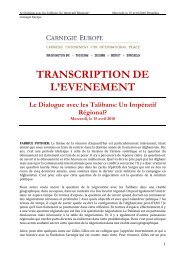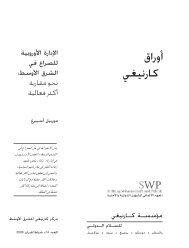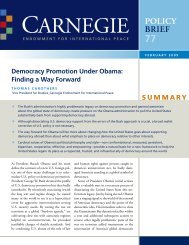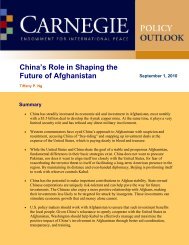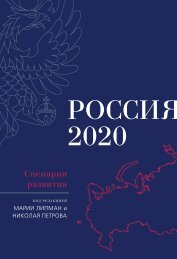Full Text (PDF) - Carnegie Endowment for International Peace
Full Text (PDF) - Carnegie Endowment for International Peace
Full Text (PDF) - Carnegie Endowment for International Peace
You also want an ePaper? Increase the reach of your titles
YUMPU automatically turns print PDFs into web optimized ePapers that Google loves.
Poor Little Rich Girl<br />
By mid-1990s, when Rosneft's privatization saga started, it already lost many valuable assets and<br />
became quite a minor player in the Russian oil sector, accounting <strong>for</strong> less than 5% of the<br />
country's oil output and oil reserves. In the pre-Yugansk era, Rosneft's contribution to the fuel<br />
and energy complex was more than modest. It was number 7 or 8 among its larger sisters in<br />
terms of oil production and reserves, drilling, refining and export volumes, and number of gas<br />
filling stations. It only did well in gas production (being number two among oil companies after<br />
Surgutneftegas), and had the smallest proportion of idle wells. Its headcount seemed frightening<br />
even among its peers that were notorious <strong>for</strong> their overemployment from the Western viewpoint.<br />
In 1996, 70,000 people worked in the company that produced only 13 mln tons of crude and 3<br />
bcm of gas and refined 4.7 mln tons 10 (to compare: ConocoPhillips and ChevronTexaco employ<br />
35,800 and 47,000 people, respectively).<br />
Rosne ft's key oil producer was Purneftegas located in the Yamal-Nenetsk Autonomous District.<br />
The subsidiary produced 8.2 mln tons of oil in 1998, i.e. more than one half of Rosneft's total<br />
output. The greater part of the territory licensed to it which is rich in high quality oil is not well<br />
explored and has a significant potential <strong>for</strong> reserve increment. Besides, Pur is the only crude<br />
producer in the region and owns the whole production infrastructure. Its main fields are<br />
relatively young and have a high daily output of wells, while water cut is roughly 45%, much<br />
lower than the average figure of 70% <strong>for</strong> West Siberia.<br />
From the very beginning, Purneftegas had an advanced and progressive management team and<br />
showed its willingness to improve transparency. Already in 1995, the company hired Price<br />
Waterhouse to audit its financial statements and OPC Ltd. to assess its oil and gas reserves. Pur<br />
was also one of the pioneers in Russia to organize roadshows and presentations to Western<br />
investors in London and New York in 1995. Even in the troubled mid-1990s, Purneftegas was<br />
successful in raising significant international and domestic credits. 11<br />
In contrast to other oil producers in Russia, Purneftegas had few expensive social obligations<br />
(such as housing, schooling, healthcare, etc.) since some 67% of Purneftegas's employees<br />
worked of the basis of the “flight- in crews.” 12<br />
Another key producing subsidiary of Rosneft, though quite minor by Russian standards, is<br />
Sakhalinmorneftegas (SMNG), which produced 1.5 million tons of oil in 1998. Its main upside<br />
potential lies in its participation in Sakhalin offshore projects (Sakhalin-1, 3, 4 and 5). In<br />
Sakhalin, the possibility of oil exports is not linked to Transneft export capacity limitations and<br />
bottlenecks, and they open a window to the fast-growing markets in the Asia-Pacific region.<br />
SMNG operates on the island of Sakhalin where crude has been produced from onshore fields<br />
since 1921 and water cut has reached 84%. It holds licenses <strong>for</strong> 42 fields with a total of 324 mln<br />
tons of ABC1 reserves. Sakhalinmorneftegas's production costs are the highest in the Russian oil<br />
industry because of the high amount of energy needed to inject steam into productive layers of<br />
viscous oil and expensive transportation of materials and equipment to this remote location.<br />
10<br />
Proceedings of the Conference: Trade and Investment Opportunities in the Russian Oil Industry, March 1996,<br />
London, p. 42.<br />
11<br />
At that time, the company received a $158 million World Bank loan and a $170 million loan from the EBRD<br />
under the oil and gas rehabilitation program.<br />
12<br />
Russian Oil. Oil Producing Companies. London, Salomon Brothers, March 1996, p. 231.<br />
4




